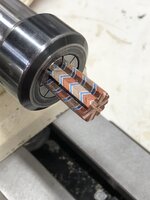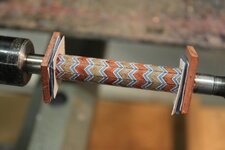Here's the scenario.
Blank is glued with epoxy or CA, for that matter. In addition to the glue, you have the blank held together by a mechanical means, eg external clamp.
While drilling, the heat becomes hot enough to soften the adhesive. Even though the glue is soft, it doesnt come apart because of the clamp. Here's my question. If you leave it clamped long enough for it to thoroughly cool, will the glue reharden ?
Ken
You've stimulated my curiosity. But I think you may not be asking the right question. Bear with me as I try to think through the issue.
First, your simple question is 'will the glue reharden' and I'm pretty sure that the simple answer is 'yes'. My understanding is that these are essentially thermoplastics which means that the pass from the solid state to the liquid state as temperature increases, but then return to the solid state when the temperature falls. But the real question that I think you wanted to ask is whether the glue bond will be as strong after the thermal excursion as it was before. I don't know the answer to that question. I suspect that it all depends on specifically which kind of glue are you dealing with, and that there are at least four issues that affect the answer.
1. The obvious issue is that if the glued components are allowed to move with respect to each other, the bond could be very different after the glue has cooled down. You mentioned that the components were held together mechanically (clamped) which may neutralize this concern except as discussed below.
2. Plastics have a 'coefficient of thermal expansion' which means that as they get hotter, they expand. So if the glue expands as it is heated, this expansion could cause glue to migrate out of the joint where it will remain after it cools. In addition, the clamping force would essentially force the joint to 'extrude', or squeeze glue out of the joint. So when the glue rehardens after the temperature excursion, it is possible that there will be less glue in the joint, which means that the strength of the joint could be compromised.
3. In addition, there is the issue of whether the molecular structure of the rehardened plastic will be the same as it was prior to being heated. I really don't know much about plastics, but, it would not surprise me to learn that there is a hysteresis effect involved that results in a change in the physical properties of the plastic (glue) as it goes through this thermal cycle. That effect could cause the internal molecular bonds within the rehardened glue to be weaker - or perhaps stronger - compared with the initial state.
4. Finally, there is the matter of how hot did it get? Again, my ignorance around this subject is pretty comprehensive, but it would not surprise me to learn that there is one temperature at which the glue starts to soften, and a higher temperature at which some other molecular changes take place within the plastic, and the strength of the rehardened glue will depend on where on that spectrum the temperature excursion ended, and also how long the temperature was elevated.
Any polymer chemists out there who can educate us? Inquiring minds want to know - - -




